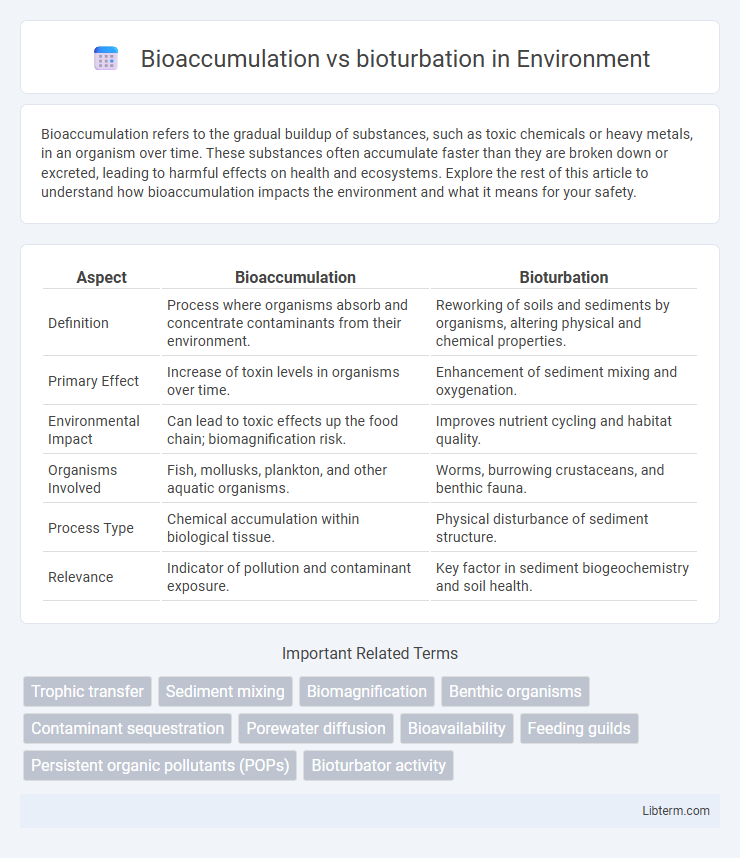Bioaccumulation refers to the gradual buildup of substances, such as toxic chemicals or heavy metals, in an organism over time. These substances often accumulate faster than they are broken down or excreted, leading to harmful effects on health and ecosystems. Explore the rest of this article to understand how bioaccumulation impacts the environment and what it means for your safety.
Table of Comparison
| Aspect | Bioaccumulation | Bioturbation |
|---|---|---|
| Definition | Process where organisms absorb and concentrate contaminants from their environment. | Reworking of soils and sediments by organisms, altering physical and chemical properties. |
| Primary Effect | Increase of toxin levels in organisms over time. | Enhancement of sediment mixing and oxygenation. |
| Environmental Impact | Can lead to toxic effects up the food chain; biomagnification risk. | Improves nutrient cycling and habitat quality. |
| Organisms Involved | Fish, mollusks, plankton, and other aquatic organisms. | Worms, burrowing crustaceans, and benthic fauna. |
| Process Type | Chemical accumulation within biological tissue. | Physical disturbance of sediment structure. |
| Relevance | Indicator of pollution and contaminant exposure. | Key factor in sediment biogeochemistry and soil health. |
Introduction to Bioaccumulation and Bioturbation
Bioaccumulation refers to the gradual accumulation of substances, such as pesticides or heavy metals, in an organism over time, often leading to higher concentrations within the organism than in its surrounding environment. Bioturbation involves the disturbance of sedimentary deposits by living organisms, such as worms or crustaceans, which affects sediment structure and nutrient cycling. Both processes play significant roles in aquatic and terrestrial ecosystems by influencing chemical distribution and sediment dynamics.
Defining Bioaccumulation: Processes and Mechanisms
Bioaccumulation refers to the gradual accumulation of substances, such as heavy metals or pollutants, in an organism over time through direct absorption from the environment or ingestion of contaminated food. Key mechanisms include bioconcentration, where chemicals are absorbed directly from water, and biomagnification, where substances increase in concentration up the food chain. This process contrasts with bioturbation, which involves the physical reworking of sediments by organisms, affecting pollutant distribution but not the internal accumulation within individual organisms.
Understanding Bioturbation: Key Concepts and Processes
Bioturbation refers to the reworking of soils and sediments by living organisms, primarily through burrowing, ingestion, and defecation activities, which significantly influence sediment structure and nutrient cycling. This process enhances sediment oxygenation and redistributes organic matter, playing a crucial role in ecosystem productivity and contaminant dynamics. Understanding bioturbation involves studying the behavior of benthic fauna and its impact on sediment mixing, contrasting with bioaccumulation where organisms accumulate contaminants internally over time.
Main Differences Between Bioaccumulation and Bioturbation
Bioaccumulation refers to the gradual buildup of substances, such as toxins or heavy metals, in the tissues of living organisms over time, often leading to increased concentrations up the food chain. Bioturbation involves the disturbance and reworking of sediment or soil by living organisms, which affects nutrient cycling and sediment structure in ecosystems. The main difference lies in bioaccumulation being a chemical concentration process within organisms, whereas bioturbation is a physical alteration of environmental materials by organism activity.
Environmental Impact of Bioaccumulation
Bioaccumulation refers to the gradual accumulation of toxic substances, such as heavy metals and persistent organic pollutants, in organisms over time, threatening ecosystems through the food web. These toxins can magnify as they move up trophic levels, leading to detrimental effects on predator species, including reproductive failure and increased mortality rates. Unlike bioturbation, which modifies sediment structure and nutrient cycling without accumulating toxins, bioaccumulation poses significant risks to biodiversity and human health due to its persistence and toxicological impact.
Ecological Consequences of Bioturbation
Bioturbation significantly alters sediment structure and chemistry, affecting nutrient cycling and oxygen penetration, which enhances microbial activity and supports diverse benthic ecosystems. The reworking of sediments by organisms disrupts contaminant bioaccumulation patterns, potentially reducing toxin concentrations in higher trophic levels. These ecological changes promote habitat complexity, improve sediment quality, and influence the overall productivity and resilience of aquatic environments.
Factors Influencing Bioaccumulation and Bioturbation
Bioaccumulation is influenced by factors such as chemical properties of contaminants, organism metabolism, exposure duration, and environmental conditions including temperature and pH. Bioturbation is affected by the diversity and behavior of benthic organisms, sediment type, oxygen availability, and disturbance frequency. Both processes are interconnected through their impact on sediment chemistry and contaminant redistribution.
Role of Organisms in Bioaccumulation vs Bioturbation
Organisms influence bioaccumulation by absorbing and concentrating contaminants through their tissues, which can lead to increased toxin levels within food webs. In bioturbation, organisms such as worms and burrowing fish actively rework sediments, altering sediment structure and chemistry, thereby affecting nutrient cycling and contaminant distribution. The contrasting roles highlight bioaccumulation as a biochemical process within organisms and bioturbation as a physical sediment disturbance driven by organism behavior.
Monitoring and Measuring Bioaccumulation and Bioturbation
Monitoring bioaccumulation involves quantifying the concentration of contaminants like heavy metals, pesticides, or persistent organic pollutants within organism tissues over time, using biomarkers and chemical analysis techniques such as mass spectrometry and chromatography. Measuring bioturbation requires assessing sediment mixing intensity and spatial distribution through methods like sediment profile imaging, tracer particle tracking, and radioisotope sediment dating to understand benthic organism activity. Combining these approaches provides critical insights into contaminant dynamics and sediment ecosystem health, essential for environmental risk assessment and management.
Future Perspectives and Research Directions
Research on bioaccumulation focuses on understanding the long-term impacts of persistent organic pollutants and heavy metals in aquatic and terrestrial food webs. Future studies aim to integrate advanced molecular techniques and environmental monitoring technologies to quantify bioaccumulation dynamics under climate change scenarios. Investigations into bioturbation emphasize its role in sediment mixing and nutrient cycling, with emerging research exploring its influence on pollutant redistribution and greenhouse gas emissions in marine and freshwater ecosystems.
Bioaccumulation Infographic

 libterm.com
libterm.com